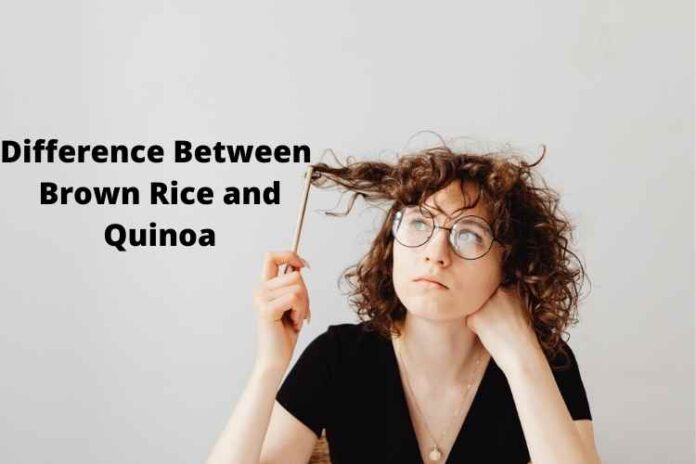In this blog we are going to tell you about Difference Between Brown Rice and Quinoa, so read this blog carefully to get the complete information.
Rice has been a common mainstay for years, however recently quinoa has emerged as a possible alternative. When deciding on quinoa vs rice, both have health advantages and upload nutritional prices in your weight loss program. However, variations in nutrition and mineral content material may additionally have barely specific results in your fitness.
What’s the Difference?
Quinoa is the dicotyledon seeds of the goosefoot plant, however, is eaten in a way much like a grain. Nutritionally just like other grains, the Dietary Guidelines for Americans consider quinoa an entire grain and categorizes it as a member of the grains meals institution.
Quinoa seeds are small and spherical, about the dimensions of a sesame seed. Although typically mild in coloration, quinoa is available in diverse colorings including purple, pink, and black. Quinoa has a rich nutty flavor and may be used as a side dish or brought to soups, salads, and baked goods.
RELATED – IS THIS ANOTHER SCAM OR OTHERWISE? TEN QUBIT REVIEWS 2022
Rice is a cereal grain fed on by greater human beings in the world than every other grain. It is available in many sorts, inclusive of basmati, jasmine, and arborio. Rice can vary in length, along with long grain and quick grain.
Unlike white rice, which has the husk, bran, and germ eliminated, brown rice handiest has the husk removed, so it keeps the nutrient-wealthy fiber and germ. For this reason, Dietary Guidelines classify brown rice as whole grain.
Comparison of Macronutrients
According to the American Heart Association, you must attempt six to 8 servings of grains every day. At least half of those need to consist of complete grains consisting of quinoa or brown rice. A serving length is a one-1/2 cup or l to the dimensions of a baseball.
The calorie content material of quinoa vs rice is similar, but brown rice has slightly less, consistent with USDA. The quantities, per half of-cup serving, are:
• Quinoa (cooked): 111 calories or 6 percent of the daily value (DV)
• Brown rice (cooked): 109 calories or five percentage DV
For assessment, quinoa also has more calories according to 1/2-cup when measuring the content material of quinoa vs oatmeal and quinoa vs pasta, consistent with USDA.
• Oatmeal (cooked): eighty-three calories or four percent DV
• Pasta (cooked): 98 calories or five percentage DV
Both are low in fat, brown rice has barely less than quinoa. You need dietary fat to supply lots of important biological and physiological methods in your frame. According to USDA, the assessment of fats content, according to half of a cup, is:
• Quinoa: 1.8 grams or three percent of the DV
• Brown rice: .8 grams or 1 percent of the DV
If you comply with a low-carb food plan, a serving of quinoa and brown rice are each proper food alternatives. Your frame needs carbs to fuel your mind, kidneys, coronary heart, muscle tissues, and central frightening device. The content material, according to a half cup, is:
• Quinoa: 19.7 grams or 7 percent of the DV
• Brown rice: 22.Nine grams or 8 percent of the DV
RELATED – WHAT DOES A COBBLER, CRUMBLE, & CRISP MEAN IN ANY DESSERT?
Comparison of Protein Content
Protein is important for the right growth, development, and restoration of every tissue in your frame. Protein is made up of amino acids, some of which your frame can not produce on its personal and must come out of your weight-reduction plan.
Although quinoa has extra protein per serving than brown rice — four.1 gram and a couple of.3 grams respectively — a chart from the Food and Agriculture Organization of the United Nations, which compares the protein breakdown of various grains, suggests both quinoa and brown rice exceed the recommendation for all vital amino acids for children three to ten years of age.
Although all grains include a few amino acids, most are low in lysine. By eating a varied eating regimen, you may get all of the protein your body desires. The Dietary Guidelines for Americans recommends you devour 10 to 35 percent of your daily energy from protein, which amounts to approximately 46 grams for grownup females and fifty-six grams for person guys.
Quinoa Is Higher in Fiber
Quinoa is higher in dietary fiber than brown rice, with the following content material consistent with a half-cup serving, in line with USDA:
• Quinoa: 2.6 grams or 10 percent of the DV
• Brown rice: 1.8 grams or 7 percent of the DV
Fiber is vital for preserving the health of your digestive machine. Dietary fiber is the portion of food that your body can not completely digest, so it remains rather intact, traveling through your digestive tract, including bulk on your stool and assisting to keep your bowel moving normally.
Fiber is no longer the most effective and facilitates the prevention of constipation, hemorrhoids, diverticulitis, and irritable bowel syndrome, but its bulking motion may also help you preserve a healthful weight_._ By slowing down digestion, fiber could make you feel “full” longer. The expanded satiety and discount in hunger may additionally make it much less in all likelihood you’ll overeat.
RELATED – What is the distinction between a fast as well as a slow metabolism?
An observation published with the aid of the Annals of Internal Medicine in February 2015, found that really including greater fiber in the weight loss program of 240 person individuals was an inexpensive alternative approach to weight reduction over a more complicated healthy diet weight-reduction plan. Furthermore, an overview in Nutrients, posted in December 2018, pronounced that high fiber may additionally assist in lower caloric absorption through binding with fats.






















